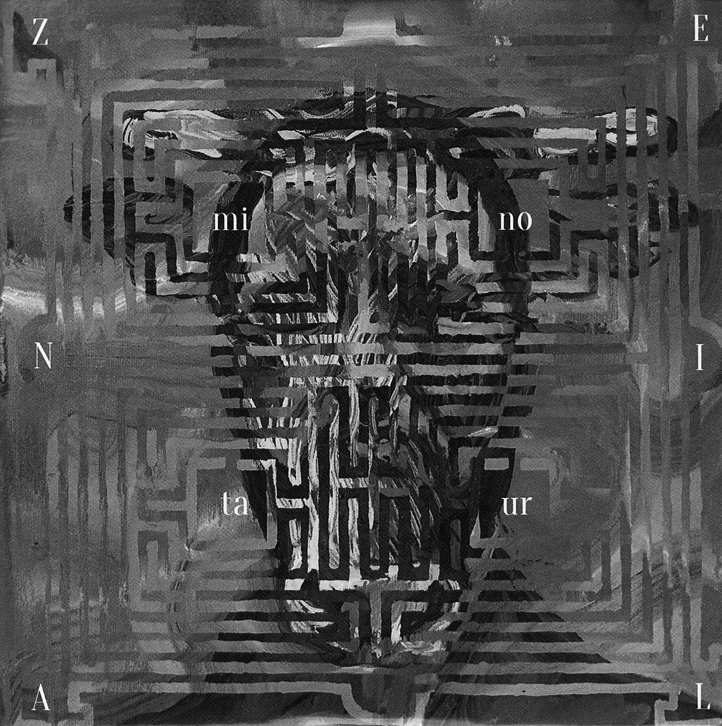Zenial: Minotaur
Compact disc, 2015, Zohar 104-2, available from Zoharum; lszalankiewicz@gmail.com; www.zenial.pl/
Reviewed by Ross Feller
Gambier, Ohio, USA
 Zenial is the name for the sound collage work by Polish sound artist Lukasz Szalankiewicz. His compact disc Minotaur contains 40 minutes of music that he claims “will appeal to fans of experimental electronica.” Five of the seven compositions on this disc were realized and recorded while the composer was in residence at the well-known Elektronmusikstudion EMS in Stockholm, Sweden, using Buchla and Serge synthesizers, samples, and various field recordings. The other pieces were extracted from a collaborative project with the Norwegian artist Jorgen Knudson. The cd cover features an evocative image by the painter Wiktor Jackowski of a man’s face imprisoned behind a labyrinth form, fittingly representing the cd’s title.
Zenial is the name for the sound collage work by Polish sound artist Lukasz Szalankiewicz. His compact disc Minotaur contains 40 minutes of music that he claims “will appeal to fans of experimental electronica.” Five of the seven compositions on this disc were realized and recorded while the composer was in residence at the well-known Elektronmusikstudion EMS in Stockholm, Sweden, using Buchla and Serge synthesizers, samples, and various field recordings. The other pieces were extracted from a collaborative project with the Norwegian artist Jorgen Knudson. The cd cover features an evocative image by the painter Wiktor Jackowski of a man’s face imprisoned behind a labyrinth form, fittingly representing the cd’s title.
The first track, Minotaur, is immediately captivating. We hear rich, analog synthesizer timbres that fade-in and crescendo in such a way as to suggest that the repeated patterns are increasingly feeding back, and quickly becoming uncontrollable. At about the 30-second mark the pieces reaches maximum amplitude, which, given the use of raw waveforms such as sawtooth waves, presents the listener with a challenging listening experience. While the repeated materials start to feed back other layers build and diminish in waves. This process leaves rhythmic traces, or trails, akin to how a spectral composer might dynamically fade various partials of a complex, fused timbre. At the rather short length of just over three minute, the listener is left with a craving for more. Functionally speaking, this track served well its introductory purpose.
Track two, Lament of Ghoul, begins with a battle between various amplitude-modulated layers over a slowly propagating simple amplitude modulation layer that uses a square wave modulator. The composer combines slow-attack amplitude envelopes with a periodic series of crescendos. There is a sense of sheer sonic delight wherein the sounds themselves organically suggest their own development. This process imitates nature more so than, say, traditional Western tonal musical practices. This track also features a gradual unfolding of chant-like vocal samples that rapidly fade in and out, and field recordings from Jerusalem and Gaza.
Hades, the third piece, presents more subtle and sparser textures than the first two works. We hear a poignant, triple meter ostinato, crescendo sweeps with time-stretched materials, against a background with cricket-like sounds. Experienced separately, this track might be perceived as overly simplistic and uninteresting. But in the context of the whole cd, it serves an ambient, ear-expanding function.
Track four, Soul Check, is from the aforementioned collaborative project with Jorgen Knudson, recorded live at a club in Braunschweig, Germany. This piece opens with an aperiodic ostinato sample that oscillates between high and low frequency sine wave sustains that could be described as screeches or screams. At various points other, brief, amplitude-modulated sounds enter the texture, adding an element of destabilization. The ostinato layers repeat at different rates. In combination, they sound unpredictable and chaotic, similar to hearing several simultaneous pulse patterns that are related by high prime numbers.
Track five, Serapeum, begins with a low frequency drone texture that undulates or vibrates rapidly. Gradually sampled layers are methodically brought into the piece, repeated and often in the disguise of a drone. The samples range from instruments to dripping water sounds that suggest a virtual space because of how they are spatialized in the mix. All of the layers repeat in a static fashion not unlike Brian Eno’s ambient work. Enjoyment of this piece is undoutable premised on one’s appreciation of the beating that occurs when rhythmic patterns some in and out of phase.
In many respects Gorgona, track six, is not unlike track five, but the undulating layers are much louder and more menacing. Beneath a repeated, filtered sawtooth wave sounding like a telephone busy signal, we hear time stretched or convolved layers that dynamically move with respect to amplitude, space, and time. Gradually the sawtooth’s filter opens to reveal more upper partial content, while the underlying layers solidify and fade out. Because of its rawness and high amplitude level, the sawtooth layer makes for some challenging and uncomfortable listening.
The last track, Live in Braunschweig: Psychopomp, is a three-minute culmination of all the techniques and materials heard in the previous six tracks. The concept of drone as a formal structure as well as a texture features prominently. But we hear drones of noise, or noisy drones, similar to the work of industrial noise bands such as the Illusion of Safety, simple in scope and effective in presentation.
Each piece on this disc presents a homogenous idea in sound. This approach makes the cd seem like a collection of demos of compositions rather than fully-realized compositions themselves. I suspect that Zenial, to be fully appreciated, must be heard live, and its recordings are only partially representative. There is a basic lack of development, or the ability to ‘run’ with an idea in order to create a musical journey that is more than mere concatenation. On the other hand, the single-minded focus can be viewed as a worthy endeavor, especially if the resultant product is thought of as inspirational fodder for future work.